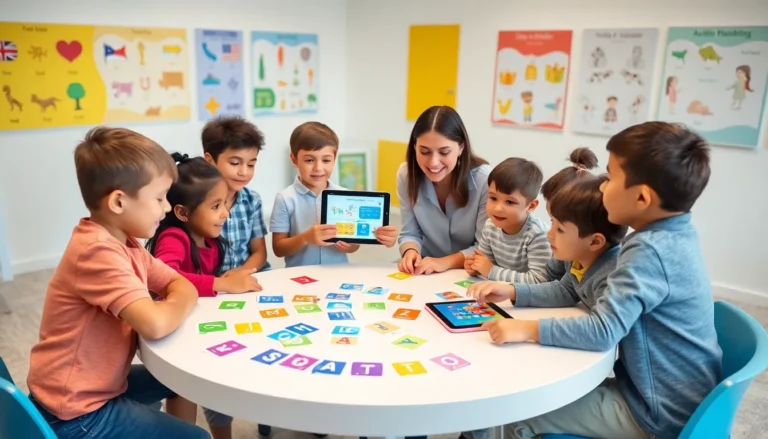Table of Contents
ToggleIn a world that feels increasingly smaller, thanks to technology, the online language learning market stands out like a neon sign in the dark alley of education. Why? Because fluency in multiple languages has never been more crucial. If learning a new language sounds like a challenging job only reserved for polyglots, buckle up. The digital age has turned that notion on its head. From innovative platforms to mobile apps that fit right in your pocket, it’s a wild ride. Let’s immerse and explore this booming market that promises to make communication easier, and possibly save you from some embarrassing travel blunders.
Overview of the Online Language Learning Market

The online language learning market has witnessed exponential growth over the past decade. According to recent studies, the global market size was valued at approximately $12 billion in 2020 and is projected to reach over $25 billion by 2026. This growth is fueled by an increasing demand for bilingual professionals in the global job market, along with the rise of remote work that makes collaboration across borders more common. Mobile applications, immersed learning environments, and user-centric designs have made language acquisition more accessible than ever before. Language enthusiasts, professionals, and students now have a plethora of options, suited for different learning styles and objectives.
Traditional language classes, with rigid schedules and trained instructors, are rapidly losing their appeal as users flock to more flexible options. They prefer platforms that allow for self-paced learning, instant feedback, and interactive experiences. This shift reflects not just a change in medium, but a profound transformation in the way individuals approach language learning. From complete beginners to advanced learners, the online market caters to a diverse audience that values convenience and personalization.
Key Drivers of Market Growth
Several key factors are propelling the online language learning market forward. First and foremost is globalization. As businesses expand internationally, the demand for employees who can navigate multiple languages grows. Companies seek employees who not only have technical skills but also the ability to communicate effectively with clients and colleagues worldwide.
Also, the COVID-19 pandemic accelerated digital engagement, revealing the importance of online education. With many in-person classes moving to digital platforms, learners embraced alternative learning methods out of necessity. This shift has initiated new habits. As a result, many now prefer online platforms over traditional classroom settings.
Affordability plays a significant role as well. Many online learning platforms offer budget-friendly subscriptions compared to traditional courses. Users soon realize they can access a wealth of resources for a fraction of the price of a physical course without sacrificing quality. This economic advantage attracts a wide range of learners, from students to working professionals.
Popular Online Language Learning Platforms
The online language learning market boasts a variety of popular platforms catering to different needs. Duolingo, known for its gamified learning approach, has amassed millions of users. With bite-sized lessons, it turns language learning into a fun and engaging game. Rosetta Stone, a long-standing leader in the field, continues to provide immersive language experiences with its speech recognition technology.
Babbel targets conversational skills, offering tailored lessons focusing on real-life dialogues. Users can quickly relate to the material presented, making it easier to apply new skills in everyday situations. Then there’s Memrise, which incorporates memory techniques to enhance vocabulary retention artistically. These platforms exemplify the range and capabilities available, showing that there’s no one-size-fits-all solution.
Also, platforms like italki provide unique opportunities for live lessons from native speakers, giving learners personal interaction that is often missing in traditional settings. Each platform brings something different to the table, making the choice more about personal preference than quality of education.
Challenges in the Online Language Learning Space
Even though its growth, the online language learning space faces several challenges that can impede progress for both learners and educators. One major issue is the lack of personalization in some programs. Learners have unique backgrounds and objectives. So, some platforms may not provide paths tailored to individual goals, which can lead to frustration or disengagement.
Besides, while online learning has come a long way, retention remains another hurdle. Many students start with enthusiasm but struggle to maintain momentum in their studies. Without the accountability found in a structured classroom setting, motivation can wane.
Technical issues can also be a barrier. Reliable internet access is crucial for effective online learning. Those in remote areas or without suitable technology may face significant disadvantages. Finally, while most apps offer interactive elements, some users may find them lacking as they miss the human interaction of face-to-face learning.
Technological Innovations Transforming Language Learning
Technological advancements are not just supporting, but revolutionizing the online language learning scene. Artificial intelligence is a game changer, providing personalized learning experiences based on user performance. This adaptability allows students to focus more on areas needing improvement effectively.
Virtual Reality allows for immersive learning experiences, helping learners practice dialogue in real-world scenarios. This innovation enhances retention and builds confidence, as users simulate actual conversations in a controlled environment.
Also, mobile apps with offline functionality enable users to continue learning without being tethered to an internet connection. With engaging content delivered through videos, podcasts, and gamified lessons, learners can progress anytime and anywhere. This flexibility further strengthens the appeal of online language learning for today’s busy lifestyles.
Future Trends in Online Language Learning
As we look towards the future, several trends are poised to shape the direction of the online language learning market. One expected trend is a shift towards more collaborative learning experiences. Social features enabling users to connect with peers, form study groups, and share learning resources will likely take center stage. Learning from one another can provide support that traditional classes often lack.
Also, continuous advancements in AI will likely drive hyper-personalization, allowing platforms to provide recommendations tailored to each user’s learning style and progress. This level of customization could transform learners’ experiences and outcomes.
Another trend is the integration of augmented reality, providing immersive experiences that help learners engage with content dynamically. This technology could make learning language rules intuitive. Finally, we might see a push for more career-focused language programs, preparing students to meet the demands of an increasingly globalized workforce.






